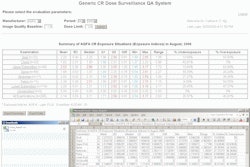CT scans are often reinterpreted when patients are transferred from one hospital's emergency department (ED) to another. But patients are also scanned again when they arrive at the new institution -- more frequently and for more dubious reasons than one might think, according to a new study from Brigham and Women's Hospital.
Researchers at the Boston hospital found that almost one-fifth of the rescans were potentially unnecessary, resulting from information technology glitches, liability concerns, and other issues that could be mitigated if greater attention were paid to them.
Better methods of transferring CT data to receiving facilities and better communication of outside radiology reports could increase efficiency, cut errors, and trim the need for repeat scans, Dr. Jeffrey Sung and colleagues wrote in the September Journal of the American College of Radiology. Much of the problem lies with images stored on CDs that accompany patients to the new institution.
"The large variety of CD user interfaces and variable system requirements makes viewing of outside studies inefficient, error prone, and at times unworkable," they wrote. "If outside images are not imported into the picture archiving and communication system (PACS) at a receiving institution, the CD serves as a patient's only local image archive" (JACR, September 2009, Vol. 6:9, pp. 626-632).
As a result, the CD often passes transiently through the radiology reading room, is less accessible to treating physicians, and is at greater risk for loss, they noted.
Other issues related to patient transfers include widely varying CT protocols and image quality between institutions, liability issues, and network security risks when a CD from the referring institution is plugged into a new hospital network, the authors wrote.
Currently, no uniform standard among receiving institutions defines the incorporation of outside imaging and imaging reports into a patient's medical record. Nevertheless, the need for rescanning can be managed, according to the authors.
In their study, Sung and colleagues sought to characterize the quantity and types of outside CT images submitted for reinterpretation among emergency department transfers to a level I trauma center at an academic institution.
Over a four-month period, participating emergency room physicians were asked to fill out a questionnaire whenever they submitted outside hospital CT data for reinterpretation at Brigham and Women's, an adult-only tertiary-care institution equipped with 43 emergency department beds.
The questionnaire asked for a brief patient history, type of CT scan, availability of outside written or verbal report, and any interpretation discrepancies between the outside report and the internal radiologist's interpretation. The questionnaire also asked physicians to state why they wanted repeat CT imaging.
Few written reports, little IT compatibility
The researchers received 255 completed questionnaires from transfer patients (57% male; mean age, 59 years). The results identified 425 CT exams submitted for reinterpretation from 59 referring sites.
The CT exams needed to be reinterpreted for various reasons. Outside or verbal reports were unavailable for 16% of patients, and even when reports were available, they weren't always usable. Discrepancies were reported in 12% (n = 27) of cases in which outside reports were available.
"Relative to the findings reported on the questionnaires, we judged our radiologists' reinterpretations to upgrade clinical severity in 30% (n = 8), to downgrade clinical severity in 44% (n = 12), and to not alter clinical severity in 26% (n = 7)," the team wrote. Discrepancies between the two reports were deemed perceptual in 26%, interpretive in 70%, and both perceptual and interpretive in 4%, the authors noted.
Of the 425 scans, 122 had to be repeated. Inadequate or incomplete imaging caused 20% of scans to be repeated, and IT issues made up 14% of repeat studies. Clinical need contributed to 52% of retakes, while various combinations of the previous three categories made up 6% of repeat studies. No reason was given for 7%. The researchers said that 57% of the studies were performed at least in part for clinical reasons and were unavoidable.
Why it happens
Emergency departments now routinely have CT available 24/7, adding to the workload of radiology departments. "The reinterpretation of outside CT imaging has thus become a necessary responsibility of radiologists covering EDs," the authors wrote. "These efforts are usually unfunded and underrecognized, yet the workload requirements continue to expand given the successful and rapid diffusion of digital technology into the healthcare community."
In the course of the handoff of patients and CT files from one institution to another, the study findings suggest significant communication errors and failures, they wrote. Formal written reports are almost nonexistent, and the lack of either written or verbal reports for 16% of patients, and discrepancies for 12%, reflect at least partially the "degradation of written and verbal communications that occur during patient handoff," they wrote.
"These communications issues strongly implicate an area in which changes could substantially improve healthcare quality for a vulnerable patient population," Sung and colleagues wrote.
IT-related reasons for rescanning -- such as inadequate scanning, CD inoperability, or unavailable imaging within the hospital's PACS -- accounted for at least 35% of repeat exams (25% of rescanned patients).
"Rescanned trauma patients in particular had a high rate (32%) of potentially avoidable reasons for rescanning," compared with 11% of nontrauma patients, they noted.
Importing images directly into the hospital's PACS is becoming an important method of using outside images because it allows, in some cases, the option of reconstructing multiplanar reformats from the source data, and it allows radiologists to view images on familiar equipment. A Web-based PACS further enables remote viewing of the images from multiple locations, they wrote.
Incompleteness and insufficient quality of imaging are two principal reasons for rescanning transferred patients, and technical issues are also an important barrier to timely access of imaging data, the authors concluded.
"Better methods of transferring CT data to receiving facilities and improved communication of outside CT reports could increase efficiency, mitigate errors, and reduce the need for repeat imaging," Sung and colleagues wrote. "These goals are worthy of additional effort and could improve the care of critically ill patients for whom transfer to tertiary care facilities is warranted."
By Eric Barnes
AuntMinnie.com staff writer
September 10, 2009
Related Reading
NEJM study: Imaging procedures, radiation growing, August 26, 2009
Automated e-mails reinforce radiology reports for important findings, August 26, 2009
Too many patients receive second negative CT pulmonary angiography: study, August 7, 2009
Off-road accidents exact heavy toll on children, July 7, 2009
Critical results software -- it's cheaper than settling lawsuits, June 5, 2009
Copyright © 2009 AuntMinnie.com



















